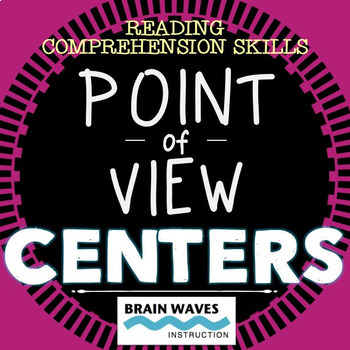Point of View Centers - 6 Stations and Point of View Activities
- PDF
What educators are saying
Also included in
- Great news! Your entire month of ELA instruction is already planned for you! This bundle includes 5 print-and-teach units that you can teach during the entire month of February! That’s right! Just download these units and you won’t have to do a bit of lesson planning! This bundle includes fivePrice $26.99Original Price $31.45Save $4.46
Description
Looking for an engaging and interactive way to teach students how to identify an author’s point of view? Then, you’re going to love this learning centers resource!
This Point of View Centers resource contains activities and lessons for 6 Point of View Learning Stations. Each center is designed to give students engaging and exciting learning experiences to practice, enrich, reteach, and enhance their learning. Working independently and with their small groups, student will have the opportunity to develop the critical reading comprehension skill of identifying and interpreting a writer’s point of view. Each center includes engaging point of view worksheets and handouts.
These centers are extremely versatile. They can be taught during a single class period, spread out over consecutive days, or taught at different times throughout the year.
The centers are completely turn-key and include everything you’ll need to implement the learning stations:
- Center Implementation Guide
- Center Table Labels
- Teacher Resources - 6 Detailed Center Overview and Set-Up Guides
- Student Packets (where students record their work from each center)
- Center Materials (includes Student Directions - with extension activities and any resource students will need to complete the activity)
- Grade Sheet (to track and grade student work)
- Keys (for all center activities)
Point of View Centers Overview:
Center 1: Identifying Opinions, Bias and Tone
Students work collaboratively to learn how an author’s opinions, bias, and tone can impact point of view.
Center 2: Article Analysis
Students read and analyze two articles and determine the point of view in each.
Center 3: Point of View Writing
Students roll point of view dice and write from the point of view of a school or community member on a specified topic.
Center 4: Point of View in Texts
Students investigate first-person, second-person, third-person-limited, and third-person-omniscient point of view by creating a foldable and reviewing 10 sample passages.
Center 5: Point of View Clues
Students work together to review clues written from the point of view of an object or animal.
Center 6: Paired Passages
Students read paired passages and investigate the different points of view in each passage.
FYI: This center resource is designed as a companion to this Point of View Mini-Unit.
You may also like…
- Memoir Study and Writing Unit
- Reading Response Project - Any Book! - Create a Newspaper
- Substitute Teacher Toolkit & Emergency Substitute Plans
Following is Fun!
Get the inside scoop on all store discounts, free products, and product launches. Just click the green “Follow Me” star under my store name on this page or click the green “Follow Me” star on my store homepage.
Let’s Stay in Touch!
*** Click HERE to receive the Brain Waves Instruction Newsletter filled with exclusive FREEBIES and Teaching Tips!
Thanks!
Brain Waves Instruction






